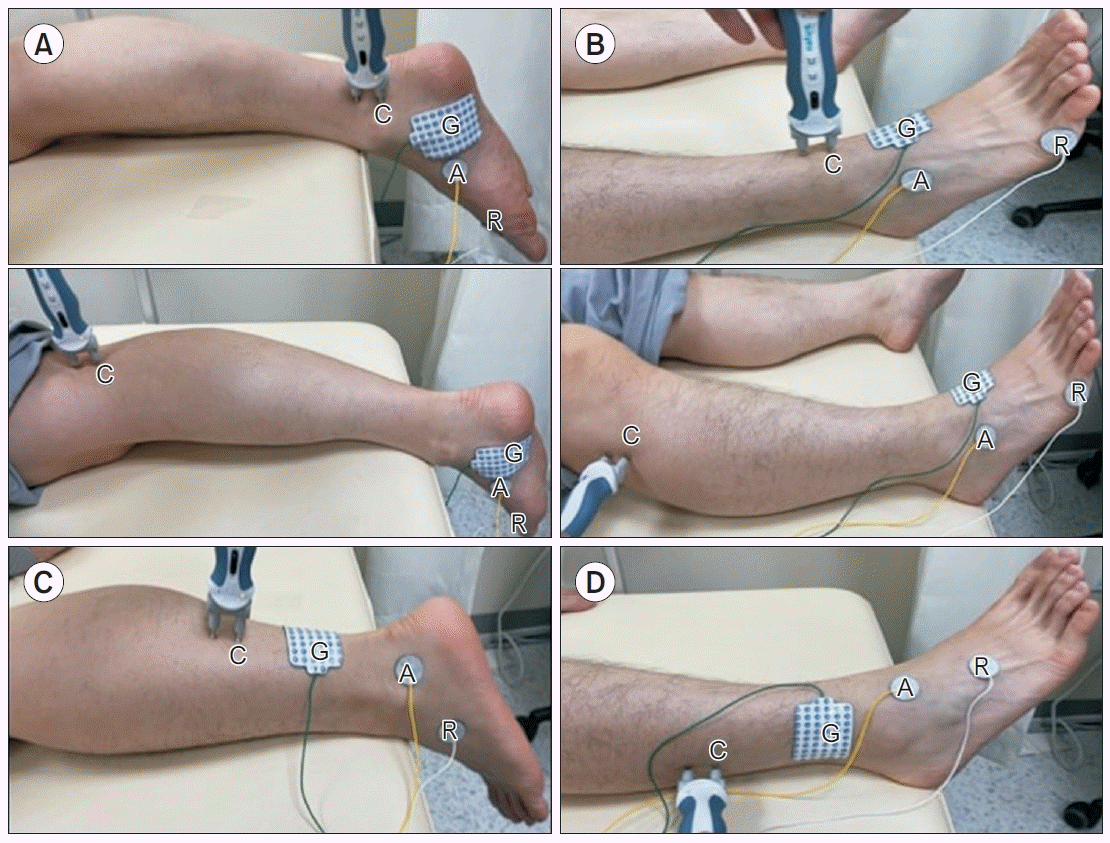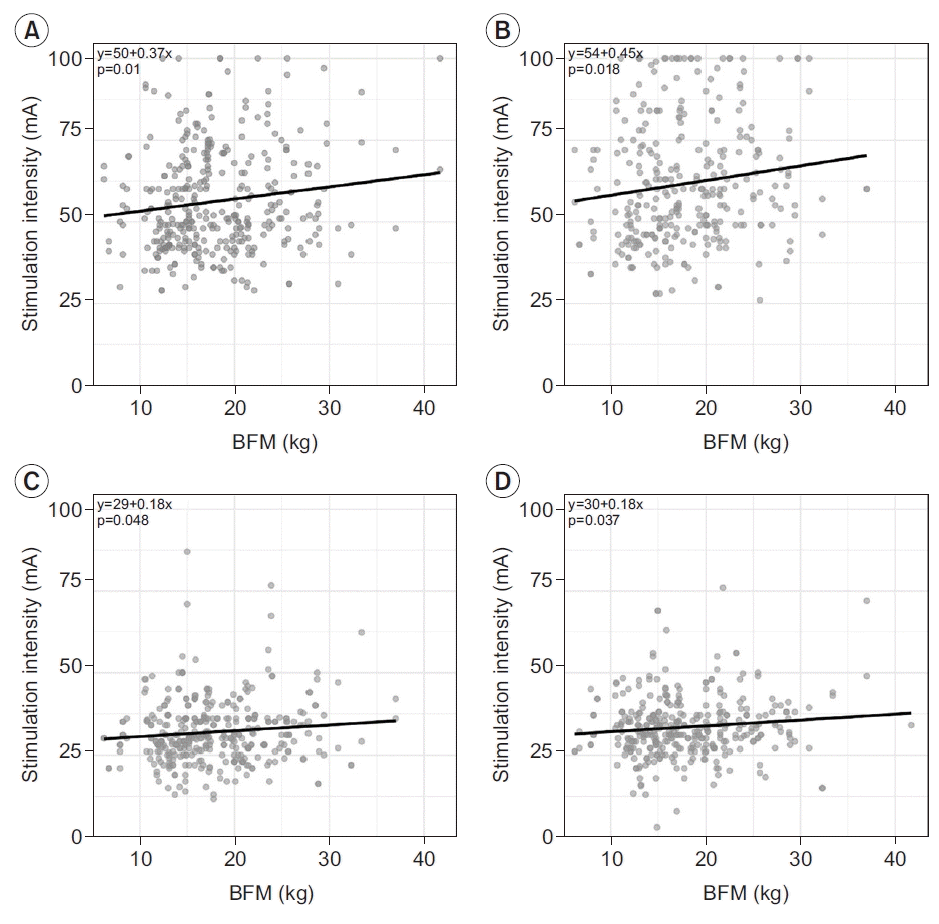INTRODUCTION
MATERIALS AND METHODS
Participants
Test settings and instruments
Test protocol for nerve conduction studies
General consideration
Tibial nerve
Common peroneal nerve
Sural nerve
Superficial peroneal nerve
Outcome parameters
Evaluation of uncertainty
Modeling the measurement
Combined standard uncertainty and expanded uncertainty
Statistical analysis
RESULTS
Demographics and anthropometrics
Supramaximal stimulus intensity
Reference values and expanded uncertainties
Table 1.
|
Male |
Female |
p-value |
||||||||
|---|---|---|---|---|---|---|---|---|---|---|
| 20s (n=100) | 50s (n=100) | 20s (n=100) | 50s (n=98) |
20s vs. 50s |
Male vs. female |
|||||
| Male | Female | 20s | 50s | |||||||
| Distal | Lonset (ms) | 4.1±1.3 (2.8–5.4) | 4.0±1.0 (3.0–5.0) | 4.0±1.2 (2.8–5.2) | 3.8±1.1 (2.7–4.8) | 0.202 | 0.009** | 0.175 | 0.001** | |
| 3rd–97th percentile | 3.1–5.4 | 3.4–5.1 | 3.1–5.4 | 3.0–4.7 | ||||||
| Ampbase-peak (mV) | 17.7±8.2 (9.5–26.0) | 16.2±7.1 (9.1–23.3) | 19.0±8.7 (10.3–27.7) | 17.0±8.7 (8.3–25.6) | 0.013* | 0.001** | 0.034* | 0.243 | ||
| 3rd–97th percentile | 10.2–24.4 | 8.4–23.3 | 12.1–27.6 | 10.2–24.4 | ||||||
| Amppeak-peak (mV) | 30.2±12.9 (17.3–43.0) | 27.2±14.8 (12.3–42.0) | 33.2±15.7 (17.6–48.9) | 28.7±13.0 (15.6–41.7) | 0.003** | <0.001** | 0.004** | 0.145 | ||
| Aneg (mVms) | 47.2±19.1 (28.1–66.3) | 39.7±22.3 (17.3–62.0) | 53.8±25.2 (28.7–79.0) | 40.6±19.2 (21.4–59.7) | <0.001** | <0.001** | <0.001** | 0.543 | ||
| Dneg (ms) | 6.1±1.8 (4.3–7.8) | 5.7±1.4 (4.3–7.1) | 6.2±1.6 (4.6–7.8) | 5.7±1.5 (4.2–7.1) | <0.001** | <0.001** | 0.229 | 0.842 | ||
| Proximal | Ampbase-peak (mV) | 14.2±6.5 (7.7–20.7) | 12.8±7.1 (5.7–19.9) | 15.2±7.7 (7.5–22.9) | 13.3±6.8 (6.5–20.1) | 0.004** | <0.001** | 0.045* | 0.299 | |
| Amppeak-peak (mV) | 24.1±10.7 (13.4–34.8) | 21.0±11.4 (9.6–32.4) | 26.9±13.3 (13.6–40.2) | 22.4±10.0 (12.3–32.4) | <0.001** | <0.001** | 0.002** | 0.082 | ||
| Aneg (mVms) | 41.7±18.6 (23.1–60.4) | 34.4±20.0 (14.5–54.4) | 48.2±23.2 (25.0–71.4) | 35.8±16.4 (19.4–52.2) | <0.001** | <0.001** | <0.001** | 0.296 | ||
| Dneg (ms) | 6.6±1.6 (5.0–8.3) | 6.2±1.5 (4.7–7.7) | 6.8±1.7 (5.1–8.5) | 6.2±1.5 (4.7–7.7) | <0.001** | <0.001** | 0.279 | 0.743 | ||
| Proximal-to-distal | NCV (m/s) | 50.3±15.2 (35.1–65.5) | 48.8±9.1 (39.6–57.9) | 49.6±14.7 (34.8–64.3) | 48.4±14.1 (34.2–62.5) | 0.056 | 0.078 | 0.390 | 0.534 | |
| 3rd–97th percentile | 37.6–63.7 | 41.7–57.8 | 39.7–59.7 | 40.8–55.9 | ||||||
| Ratioarea | 0.89±0.22 (0.67–1.10) | 0.87±0.15 (0.72–1.02) | 0.90±0.19 (0.71–1.09) | 0.89±0.14 (0.75–1.02) | 0.225 | 0.344 | 0.395 | 0.093 | ||
| Ratioamp | 0.81±0.24 (0.57–1.05) | 0.79±0.16 (0.63–0.95) | 0.80±0.15 (0.65–0.95) | 0.79±0.14 (0.65–0.93) | 0.158 | 0.312 | 0.563 | 0.968 | ||
Values are presented as mean±expanded uncertainty (range). However, Aneg, Dneg, and Ratioarea are presented as mean±2 standard deviation (range).
Lonset, onset latency; Ampbase-peak, baseline to negative peak amplitude; Amppeak-peak, negative peak to positive peak amplitude; Aneg, negative spike area; Dneg, negative spike duration; NCV, nerve conduction velocity; Ratioarea, proximal-to-distal area ratio; Ratioamp, proximal-to-distal amplitude ratio.
Table 2.
|
Male |
Female |
p-value |
||||||||
|---|---|---|---|---|---|---|---|---|---|---|
| 20s (n=100) | 50s (n=100) | 20s (n=100) | 50s (n=98) |
20s vs. 50s |
Male vs. female |
|||||
| Male | Female | 20s | 50s | |||||||
| Distal | Lonset (ms) | 4.3±1.2 (3.1–5.4) | 4.2±1.4 (2.8–5.6) | 4.1±1.7 (2.5–5.8) | 4.0±1.4 (2.7–5.4) | 0.694 | 0.218 | 0.261 | 0.029* | |
| 3rd–97th percentile | 3.2–5.3 | 3.1–5.5 | 2.9–5.9 | 2.8–5.1 | ||||||
| Ampbase-peak (mV) | 7.1±3.8 (3.4–10.9) | 5.9±3.8 (2.1–9.8) | 6.0±3.1 (2.9–9.0) | 4.8±2.7 (2.1–7.5) | <0.001** | <0.001** | <0.001** | <0.001** | ||
| 3rd–97th percentile | 4.1–11.1 | 3.0–9.3 | 3.3–8.8 | 2.8–7.1 | ||||||
| Amppeak-peak (mV) | 11.6±6.4 (5.1–18.0) | 9.3±6.5 (2.9–15.8) | 9.9±5.3 (4.5–15.1) | 7.4±4.5 (2.9–11.9) | <0.001** | <0.001** | <0.001** | <0.001** | ||
| Aneg (mVms) | 21.2±13.1 (8.1–34.3) | 16.2±11.4 (4.8–27.6) | 18.1±9.4 (8.7–27.5) | 13.4±8.1 (5.2–21.5) | <0.001** | <0.001** | <0.001** | <0.001** | ||
| Dneg (ms) | 5.9±1.7 (4.3–7.6) | 5.5±1.4 (4.1–7.0) | 6.1±1.9 (4.1–8.0) | 5.6±1.4 (4.2–7.0) | <0.001** | <0.001** | 0.253 | 0.762 | ||
| Proximal | Ampbase-peak (mV) | 6.7±3.6 (3.1–10.3) | 5.4±3.6 (1.8–9.0) | 5.6±3.0 (2.6–8.6) | 4.4±2.6 (1.8–7.0) | <0.001** | <0.001** | <0.001** | <0.001** | |
| Amppeak-peak (mV) | 10.7±5.8 (4.9–16.5) | 8.4±6.0 (2.3–14.4) | 9.1±5.2 (4.0–14.3) | 6.8±4.3 (2.5–11.1) | <0.001** | <0.001** | <0.001** | <0.001** | ||
| Aneg (mVms) | 20.9±12.8 (8.1–33.7) | 15.7±11.0 (4.7–26.7) | 17.8±4.5 (8.3–27.2) | 12.9±7.8 (5.1–20.7) | <0.001** | <0.001** | <0.001** | <0.001** | ||
| Dneg (ms) | 6.3±1.7 (4.6–8.1) | 6.1±1.5 (4.7–7.6) | 6.4±2.0 (4.4–8.4) | 6.0±1.5 (4.5–7.4) | 0.033* | <0.001** | 0.395 | 0.430 | ||
| Proximal-to-distal | NCV (m/s) | 50.7±8.5 (42.2–59.3) | 49.0±8.2 (40.8–57.3) | 51.3±14.0 (37.2–65.3) | 50.7±13.7 (37.0–64.4) | 0.002** | 0.354 | 0.345 | 0.003** | |
| 3rd–97th percentile | 44.8–58.2 | 42.4–57.3 | 44.5–57.7 | 43.3–58.9 | ||||||
| Ratioarea | 0.98±0.14 (0.84–1.12) | 0.97±0.19 (0.78–1.16) | 0.97±0.13 (0.83–1.10) | 0.95±0.18 (0.77–1.13) | 0.485 | 0.171 | 0.436 | 0.260 | ||
| Ratioamp | 0.93±0.19 (0.74–1.12) | 0.90±0.24 (0.66–1.14) | 0.93±0.17 (0.77–1.10) | 0.91±0.21 (0.70–1.11) | 0.019* | 0.012* | 0.939 | 0.733 | ||
Values are presented as mean±expanded uncertainty (range). However, Aneg, Dneg, and Ratioarea are presented as mean±2 standard deviation (range).
Lonset, onset latency; Ampbase-peak, baseline to negative peak amplitude; Amppeak-peak, negative peak to positive peak amplitude; Aneg, negative spike area; Dneg, negative spike duration; NCV, nerve conduction velocity; Ratioarea, proximal-to-distal area ratio; Ratioamp, proximal-to-distal amplitude ratio.
Table 3.
|
Male |
Female |
p-value |
|||||||
|---|---|---|---|---|---|---|---|---|---|
| 20s (n=100) | 50s (n=100) | 20s (n=100) | 50s (n=98) |
20s vs. 50s |
Male vs. female |
||||
| Male | Female | 20s | 50s | ||||||
| Lonset (ms) | 2.9±0.7 (2.2–3.6) | 2.9±0.7 (2.2–3.5) | 2.8±0.7 (2.2–3.5) | 2.8±0.7 (2.0–3.5) | 0.193 | 0.020* | 0.039* | 0.003** | |
| 3rd–97th percentile | 2.4–3.3 | 2.4–3.3 | 2.4–3.3 | 2.2–3.3 | |||||
| Ampbase-peak (μV) | 26.8±15.5 (11.3–42.3) | 21.7±11.9 (9.8–33.6) | 29.4±14.5 (14.9–43.8) | 23.9±13.5 (10.4–37.4) | <0.001** | <0.001** | 0.010* | 0.010* | |
| 3rd–97th percentile | 14.0–39.1 | 14.1–31.3 | 13.7–39.7 | 13.8–35.4 | |||||
| Amppeak-peak (μV) | 28.3±19.7 (8.6–48.0) | 23.3±14.2 (9.1–37.5) | 31.3±18.0 (13.3–49.3) | 26.1±15.9 (10.2–41.9) | <0.001** | <0.001** | 0.022* | 0.008** | |
| 3rd–97th percentile | 13.0–47.6 | 12.2–36.2 | 13.2–48.1 | 14.4–41.8 | |||||
| Aneg (μVms) | 19.2±14.6 (4.6–33.8) | 14.3±8.8 (5.5–23.1) | 20.5±13.6 (6.9–34.1) | 16.3±11.6 (4.7–27.9) | <0.001*** | <0.001** | 0.189 | 0.007** | |
| Dneg (ms) | 1.9±0.6 (1.3–2.5) | 1.9±0.6 (1.3–2.5) | 1.8±0.4 (1.4–2.2) | 1.8±0.4 (1.4–2.2) | 0.795 | 0.077 | 0.001** | 0.082 | |
Values are presented as mean±expanded uncertainty (range). However, Aneg and Dneg, are presented as mean±2 standard deviation (range).
Lonset, onset latency; Ampbase-peak, baseline to negative peak amplitude; Amppeak-peak, negative peak to positive peak amplitude; Aneg, negative spike area; Dneg, negative spike duration.
Table 4.
|
Male |
Female |
p-value |
|||||||
|---|---|---|---|---|---|---|---|---|---|
| 20s (n=100) | 50s (n=100) | 20s (n=100) | 50s (n=98) |
20s vs. 50s |
Male vs. female |
||||
| Male | Female | 20s | 50s | ||||||
| Lonset (ms) | 2.9±0.6 (2.2–3.5) | 2.9±0.7 (2.2–3.6) | 2.7±0.6 (2.1–3.4) | 2.7±0.7 (2.0–3.4) | 0.053 | 0.536 | 0.002** | <0.001** | |
| 3rd–97th percentile | 2.4–3.3 | 2.4–3.4 | 2.4–3.1 | 2.2–3.3 | |||||
| Ampbase-peak (μV) | 21.7±13.5 (8.3–35.2) | 17.1±12.4 (4.7–29.5) | 23.7±14.1 (9.6–37.9) | 18.2±10.5 (7.7–28.8) | <0.001** | <0.001** | 0.030* | 0.129 | |
| 3rd–97th percentile | 12.7–34.3 | 9.3–28.6 | 12.8–37.9 | 10.7–27.7 | |||||
| Amppeak-peak (μV) | 23.6±19.1 (4.5–42.7) | 18.6±14.6 (4.0–33.2) | 26.9±19.0 (7.9–45.9) | 20.1±13.9 (6.2–34.1) | <0.001** | <0.001** | 0.014* | 0.131 | |
| 3rd–97th percentile | 11.7–44.3 | 8.8–31.6 | 12.0–44.4 | 10.0–34.8 | |||||
| Aneg (μVms) | 15.4±11.2 (4.2–26.6) | 11.2±10.2 (1.0–21.4) | 17.5±12.4 (5.1–29.9) | 12.1±8.2 (3.9–20.3) | <0.001** | <0.001** | 0.011* | 0.186 | |
| Dneg (ms) | 2.0±0.8 (1.2–2.8) | 2.1±0.6 (1.5–2.7) | 1.9±0.6 (1.3–2.5) | 2.0±0.8 (1.2–2.8) | 0.462 | 0.571 | 0.206 | 0.206 | |
Values are presented as mean±expanded uncertainty (range). However, Aneg and Dneg, are presented as mean±2 standard deviation (range).
Lonset, onset latency; Ampbase-peak, baseline to negative peak amplitude; Amppeak-peak, negative peak to positive peak amplitude; Aneg, negative spike area; Dneg, negative spike duration.
Anatomical variation
Side-to-side difference and proximal-to-distal difference
Table 5.
|
Side-to-side difference |
||
|---|---|---|
| Mean±SD | Mean+2SD | |
| Tibial nerve | ||
| Lonset (ms) | 0.47±0.45 | 1.37 |
| Ampbase-peak (%) | 18.46±13.80 | 46.06a) |
| NCV (%) | 8.42±7.51 | 23.44b) |
| Common peroneal nerve | ||
| Lonset (ms) | 0.42±0.42 | 1.26 |
| Ampbase-peak (%) | 19.50±15.09 | 49.68 |
| NCV (%) | 5.85±5.04 | 15.93 |
| Sural nerve | ||
| Lonset (ms) | 0.13±0.11 | 0.35 |
| Ampbase-peak (%) | 10.23±8.61 | 27.45 |
| Amppeak-peak (%) | 14.14±10.67 | 35.48 |
| Superficial peroneal nerve | ||
| Lonset (ms) | 0.17±0.15 | 0.47 |
| Ampbase-peak (%) | 11.99±9.93 | 31.85 |
| Amppeak-peak (%) | 14.24±10.38 | 35.00 |




 PDF
PDF Citation
Citation Print
Print





 XML Download
XML Download